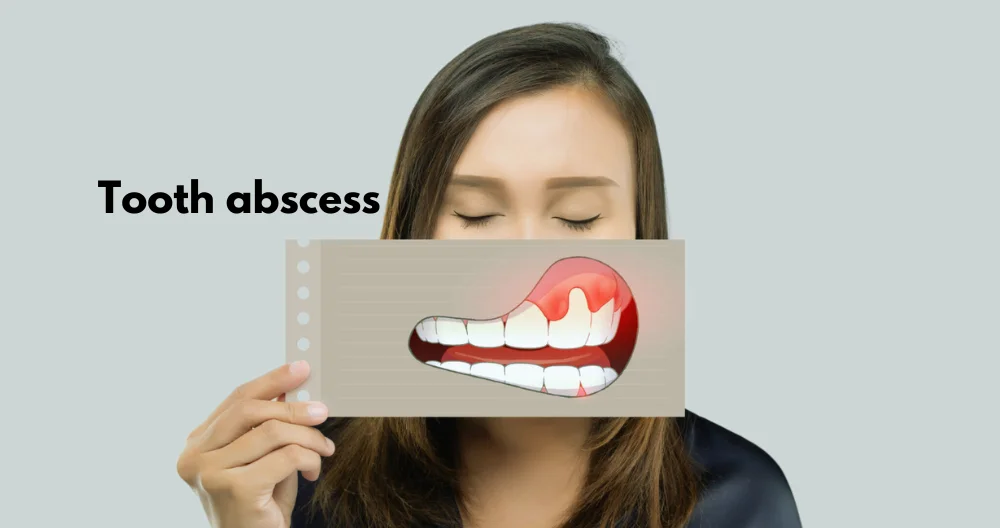Tooth Abscess – Symptoms, Causes & Treatment
A tooth abscess can result in pulsating discomfort. However, appropriate treatment can alleviate these symptoms within a few days. Neglecting to treat an abscessed tooth may lead to serious complications.
What is a Tooth abscess?
An abscessed tooth Is a collection of pus caused by bacterial infection. This condition manifests in various locations around the tooth, each with its cause. Specifically a periapical abscess specifically occurs at the tip of a tooth’s root, whereas a periodontal abscess emerges in the gum area adjacent to the root of the tooth. This discussion primarily focuses on periapical abscesses.
Such an abscess at the root’s tip typically results from neglecting a dental cavity, physical trauma, or previous dental procedures. This infection triggers inflammation, marked by irritation and swelling, leading to abscess formation at the root’s end.
The primary goal in treating a tooth abscess is for dentists to drain the abscess and eradicate the infection. Often, this treatment may include performing a root canal procedure to preserve the tooth. However, in certain scenarios, extracting the tooth becomes necessary. Neglecting treatment for an abscessed tooth can have severe, potentially life-threatening consequences.
What are the different types of dental abscesses?
Dental abscesses vary based on their location within the oral cavity. The three primary types include:
- Periapical Abscess: This abscess forms at the root tip of a tooth.
- Periodontal Abscess: Located on the gum adjacent to a tooth’s root, this abscess can also extend to nearby tissues and bone.
- Gingival Abscess: This kind of abscess is typically located on the gum tissue.
Symptoms of Tooth abscess
- Intense, unrelenting toothache with a pulsating sensation, potentially radiating to the jaw, neck, or ear.
- Discomfort or sensitivity to hot and cold temperatures.
- Discomfort or pain while chewing or biting.
- Elevated body temperature.
- Facial, cheek, or neck swelling, possibly causing difficulties in breathing or swallowing.
- Tender, enlarged lymph nodes beneath the jaw or in the neck area.
- Unpleasant breath odor.
- A sudden release of bad-smelling, salty-tasting fluid in the mouth accompanied by a decrease in pain, indicative of the abscess bursting.
Consult With Doctor
It’s important to consult your dentist immediately if you notice any indications of a dental abscess.
Should you experience facial swelling and fever and are unable to contact your dentist, seek immediate care at an emergency room. Additionally, if you’re experiencing difficulties in breathing or swallowing, immediate emergency care is crucial. These symptoms could signify that the infection has extended into your jaw, throat, neck, or potentially other parts of your body.
Causes of dental abscesses
A periapical dental abscess is caused by bacterial infiltration into the dental pulp, which is the tooth’s inner region consisting of blood vessels, nerves, and connective tissue.
The bacteria can gain access through a dental cavity or a fissure or break in the tooth, eventually reaching the root. The invasion of bacteria can result in inflammation and swelling at the tip of the root.
Risk Factors
Certain factors can heighten the likelihood of developing a tooth abscess:
- Inadequate Dental Hygiene: Neglecting proper oral care, like not brushing teeth twice daily or failing to floss, can heighten the risk of dental issues. These problems can include a variety of oral health complications, such as tooth decay, gum disease, dental abscesses, and other dental issues.
- Sugar-Rich Diet: Regular consumption of sugar-laden foods and beverages, including sweets and soft drinks, can lead to dental cavities, which may evolve into a tooth abscess.
- Xerostomia (Dry Mouth): A dry mouth condition increases the likelihood of tooth decay. This condition frequently occurs as a side effect of various medications or is associated with the ageing process.
Treatment for a Tooth Abscess
The primary goal in treating a dental abscess is to eradicate the infection and alleviate pain.
Your dentist might start the treatment process with a dental X-ray to assess if the infection has extended beyond the initial area.
Depending on the type and severity of the abscess, various treatment approaches are available:
- Draining the Abscess: The dentist performs a minor incision to release the pus and then cleanses the area with a saline solution.
- Root Canal Procedure: This treatment involves drilling the affected tooth to remove the abscess and the infected pulp. The dentist fills and seals the pulp chamber and root canal. Often, a follow-up appointment is scheduled to place a crown over the tooth for added strength.
- Tooth Extraction: If the tooth is too damaged to be saved, it might be removed prior to draining the abscess.
- Antibiotics: In cases where the infection has spread or if the patient has a compromised immune system, oral antibiotics are often prescribed.
- Removal of Foreign Object: If a foreign object in the gums causes the abscess, the dentist will extract it and then clean the area with saline.
To alleviate pain before a dental visit, over-the-counter anti-inflammatory medications like ibuprofen (Advil, Motrin) can be used. Rinsing the mouth with warm salt water may also provide some relief.
Complications
Seeking dental care for an abscessed tooth is essential. Professional evaluation and cleaning are vital, even if the abscess has already ruptured, to ensure the infection doesn’t spread further.
An untreated abscess can grow, potentially affecting the jaw, and could spread to other parts of the head and neck, even reaching the brain. In severe instances, this could result in sepsis, a life-threatening infection complication.
If you have an abscessed tooth accompanied by any of the symptoms listed below, it is critical to get emergency medical attention without delay:
- Elevated fever
- Noticeable facial swelling
- Difficulty in swallowing
- Rapid heartbeat
- Confusion
These symptoms indicate a severe infection requiring urgent medical attention.
Final Words
Typically, a Tooth abscess should improve within several days following treatment. However, it’s vital to consult with your dentist, even if the abscess appears to drain spontaneously, to ensure the infection doesn’t migrate elsewhere.
To minimize the likelihood of developing an abscessed tooth, maintaining diligent oral hygiene and undergoing routine dental examinations every six months is recommended.
Review By:
Dr Jason H. Nordean reviews this article.

